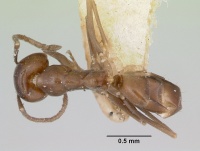Dorymyrmex wheeleri
| Dorymyrmex wheeleri | |
|---|---|

| |
| Scientific classification | |
| Kingdom: | Animalia |
| Phylum: | Arthropoda |
| Class: | Insecta |
| Order: | Hymenoptera |
| Family: | Formicidae |
| Subfamily: | Dolichoderinae |
| Tribe: | Leptomyrmecini |
| Genus: | Dorymyrmex |
| Species: | D. wheeleri |
| Binomial name | |
| Dorymyrmex wheeleri (Kusnezov, 1952) | |
Remains known from only two workers collected in 1933.
Identification
Snelling (1995) - A characteristic that will separate D. wheeleri from all previously described North American Dorymyrmex: the sparsely pubescent frons, the hairs of which are separated from adjacent hairs by several times their own widths (in the paralectotype many of the hairs are separated by their own lengths or more). In the paralectotype the entire frons is smooth and shiny, but in the lectotype most of the frons is distinctly shagreened.
The head shape is about as in D. insanus: lateral margins weakly convex, vertex margin so weakly convex that it is nearly flat. The profile of the mesonotum is flat and with a distinctly sloping posterior face. The mostly convex basal face of the propodeum is abruptly depressed behind, to form a distinct transverse crease in front of the short, acute tubercle.
These two workers appear to be nanitic, and I have seen no specimens like them in any of the numerous collections of Dorymyrmex available from the Tucson area.
Keys including this Species
Distribution
Latitudinal Distribution Pattern
Latitudinal Range: 37.187483° to 34.924°.
| North Temperate |
North Subtropical |
Tropical | South Subtropical |
South Temperate |
- Source: AntMaps
Distribution based on Regional Taxon Lists
Nearctic Region: United States (type locality).
Distribution based on AntMaps
Distribution based on AntWeb specimens
Check data from AntWeb
Countries Occupied
| Number of countries occupied by this species based on AntWiki Regional Taxon Lists. In general, fewer countries occupied indicates a narrower range, while more countries indicates a more widespread species. |

|
Estimated Abundance
| Relative abundance based on number of AntMaps records per species (this species within the purple bar). Fewer records (to the left) indicates a less abundant/encountered species while more records (to the right) indicates more abundant/encountered species. |

|
Biology
Castes
Nomenclature
The following information is derived from Barry Bolton's Online Catalogue of the Ants of the World.
- wheeleri. Conomyrma (Biconomyrma) wheeleri Kusnezov, 1952g: 438 (w.) U.S.A. Combination in Dorymyrmex: Snelling, R.R. 1995: 8. Junior synonym of insanus: Snelling, R.R. 1973b: 5. Revived from synonymy: Snelling, R.R. 1995: 8.
Unless otherwise noted the text for the remainder of this section is reported from the publication that includes the original description.
Description
Worker
Snelling (1995) - (mm) lectotype (paralectotype): HL 0.73 (0.62); HW 0.60 (0.51); SL 0.71 (0.59); EL 0.19 (0.17); TL 2.5 (2.2). Indices and ratios: CI 82 (83); SI 97 (96); Slz 117 (115); 01 26 (27); OMR 93 (85); IOR 153 (146).
Type Material
Snelling (1995) - This species was described from two workers collected by P. Klingenberg at "College P. A.," Tucson, Arizona, on 22 March 1933; a specific holotype was not designated. A female specimen in the MCZ collection, perhaps conspecific with the two workers, has a similar label, with identical data, and a label written by W.M. Wheeler; "Dorymyrmex pyramicus n. subsp."
The locality data as cited by Kusnezov are incorrect: the first line of the label reads "College P. K." on both samples. According to F.G. Werner (personal communication), P. Klingenberg collected specimens in Arizona and sent them to W.M. Wheeler. Apparently, when the specimens were mounted and the labels written, the notation "coil. P. K." (= collector P. Klingenberg) became "College P. K.," misquored by Kusnezov as "College P. A." A further distortion is that of Shattuck (1994), who translated the citation to read "College Park, Tucson."
Of the two syntypes, the larger is here designated lectotype; the second specimen is the paralectotype.
References
- Godfrey, R.K., Oberski, J.T., Allmark, T., Givens, C., Hernandez-Rivera, J., Gronenberg, W. 2021. Olfactory system morphology suggests colony size drives trait evolution in Odorous Ants (Formicidae: Dolichoderinae). Frontiers in Ecology and Evolution 9, 733023 (doi:10.3389/fevo.2021.733023).
- Snelling, R. R. 1973b. The ant genus Conomyrma in the United States (Hymenoptera: Formicidae). Contr. Sci. (Los Angel.) 238: 1-6 (page 5, Junior synonym of insanus)
- Snelling, R. R. 1995a. Systematics of Nearctic ants of the genus Dorymyrmex (Hymenoptera: Formicidae). Contributions in Science (Los Angeles, Calif.). 454:1-14. (page 8, Combination in Dorymyrmex, Revived from synonymy)
References based on Global Ant Biodiversity Informatics
- Kusnezov N. 1952. El estado real del grupo Dorymyrmex Mayr (Hymenoptera, Formicidae). Acta Zoologica Lilloana 10: 427-448.

